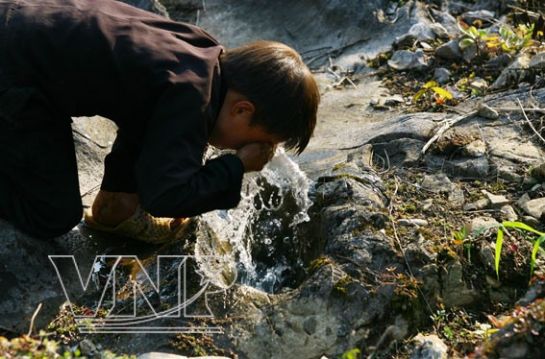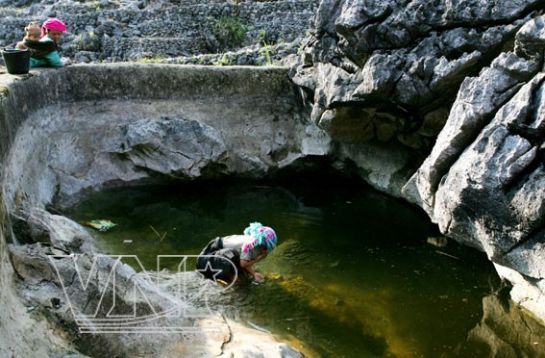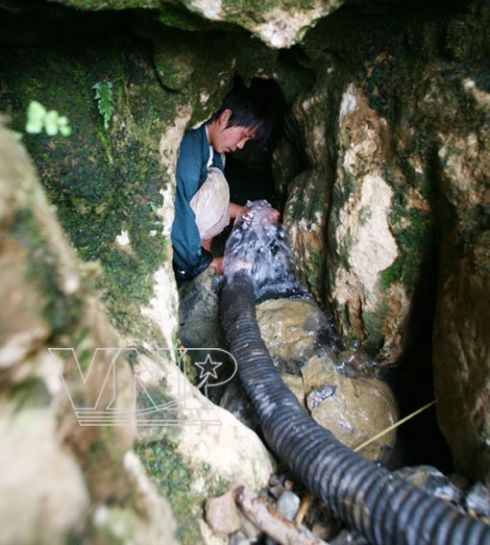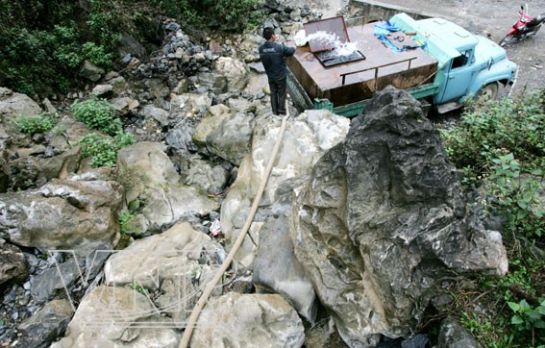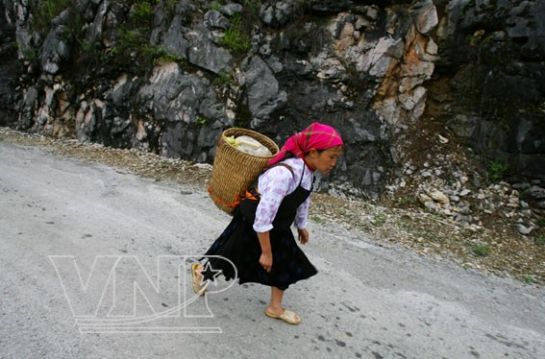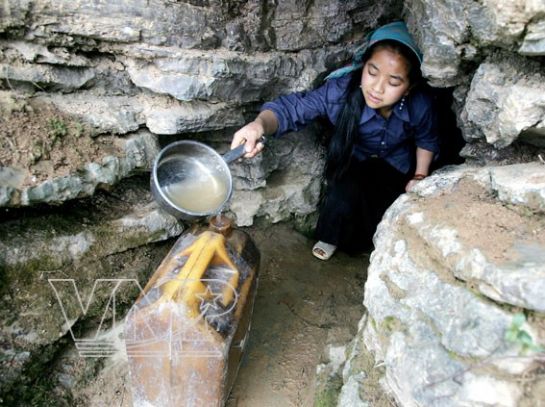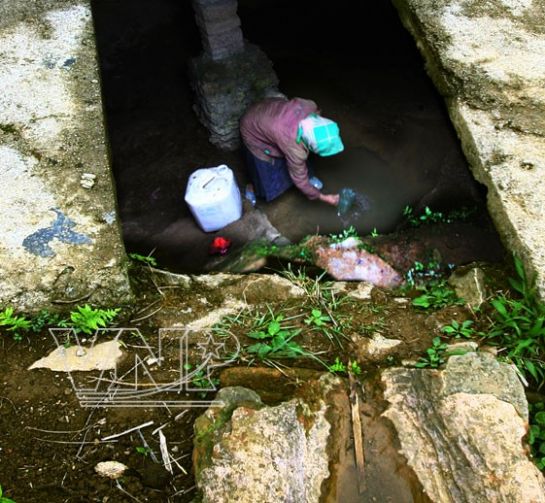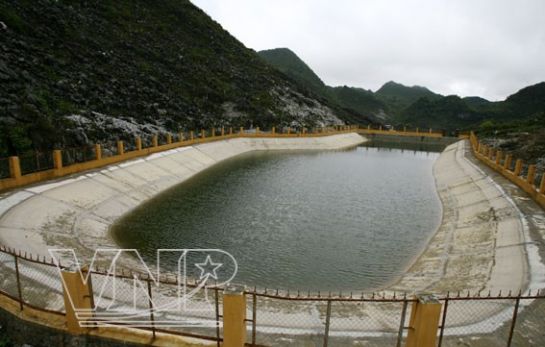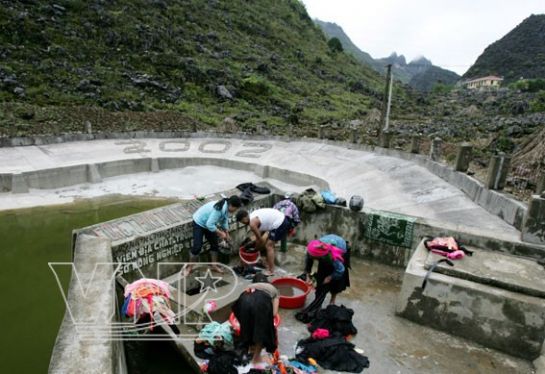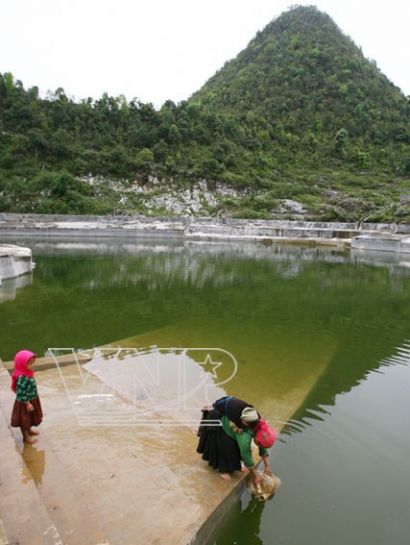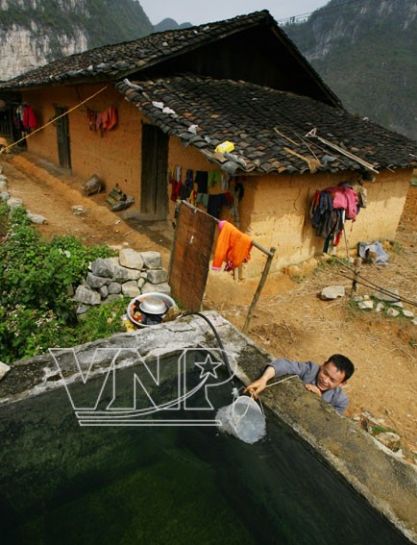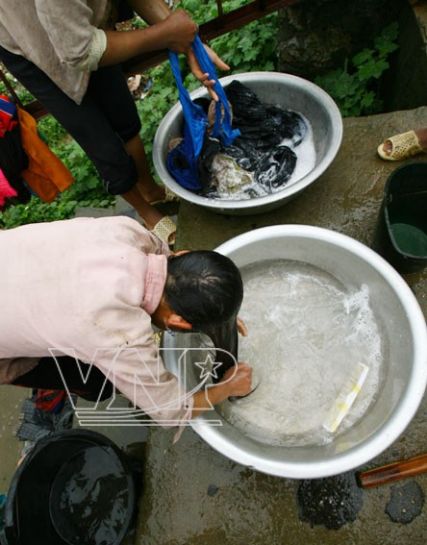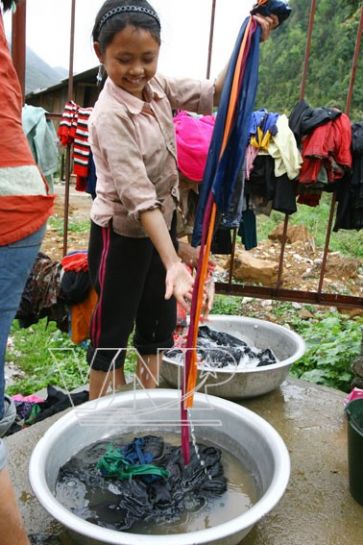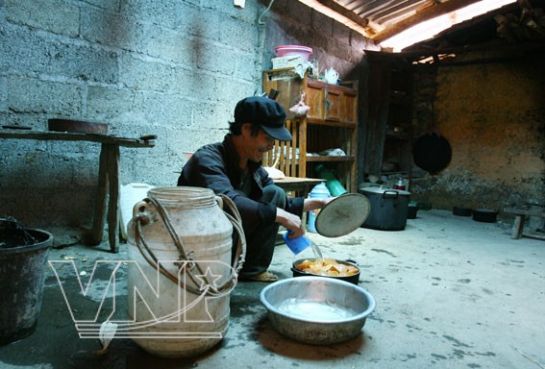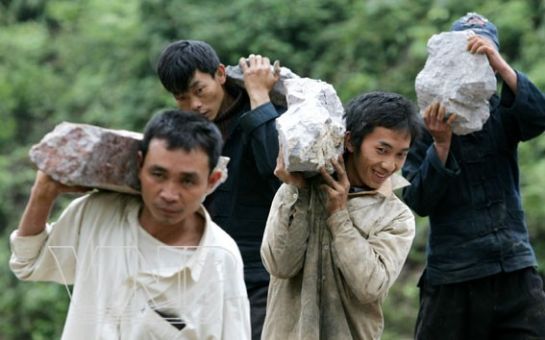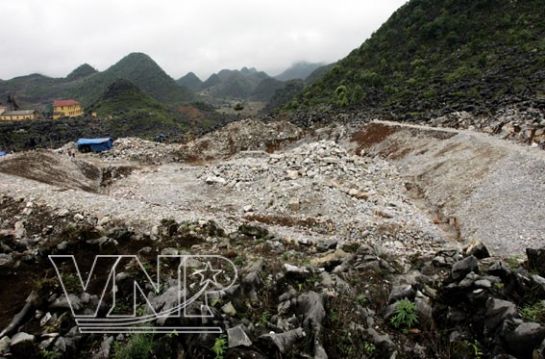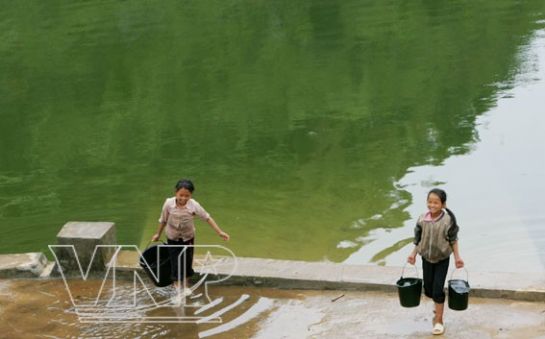At the height of 1,000-1,400m above sea level, rugged mountains make up most of this plateaus natural acreage. Living in such a harsh nature, the local residents are in a great shortage of land for cultivation and water all the year round.
A project to build a hanging reservoir on the mountain side in this area has been implemented efficiently which will help solve the problem of not having enough water for the locals life.
On the way to Meo Vac District we saw groups of ethnic people, including the elderly and children, fetching water. They carried papooses on their back, held cans of water in their hands and tied more cans around their waist. Giang Dong No, a Mong ethnic man who was carrying a water jar on his way home to Can Chu Phin Commune, in broken Vietnamese explained to us: "I don’t have any water near my home so I must trek over several mountains to get it.”
In
Dong Van District, we talked with a 10-year-old Mong boy, Giang Mi Dia,
who was on his way home. When the school was over he hurried to fetch
water from the rocky caves and carried a small papoose with a 5-litre can
of water inside on his back. The precious water he found, either from
caves or streams, was transferred into the can without spilling a drop.
Sung Dai Hung, Chairman of Dong Van District People’s Committee, said: "In the dry season the local people have to spend much of their time fetching water. Back home they have to keep the water stored for a few days to get it clean before using. Those who have such sources of water are really lucky, because out of 19 communes and one district, only the two communes of Ma Le and Pho Cao have a regular supply of water. The rest don’t even have a source.”
Through on-the-spot surveys, scientists found out that in the dry season the four upland districts of Ha Giang Province still has underground water. Due to geographical terrains and tectonic forming, in those districts after raining, water quickly absorbs into the limestone layers, running through caves and cracks towards the lower places, then creating currents underground and inside the mountains. Those currents will gather in some places and form into streams. With these findings, scientists have so far expected to find some solutions to the water shortage problem.
Our
car climbed to the top of Ma Pi Leng Mountain in Meo Vac District, Ha
Giang Province, then crossed the "Heaven’s Gate" Xa Phin in Dong Van
District. From there we saw on the valleys below the prevailing dark grey
colour of rocks.
During our two weeks of traveling to hamlets of the Mong,
Dao, Lo Lo, and Giay ethnic groups, we heard many stories, both happy and
sorrowful, about the local people's life, but mostly about their struggle
for water.
Residents on this rocky plateau said that nowhere in Vietnam is water more needed than in the four upland districts of Ha Giang Province. In the dry season, from late October to April, lacking water is very normal.
With a
hope of getting some remarks from the scientists on such a difficult
problem we met Doctor of Science Vu Cao Minh, who not long ago was the
head of a scientific project titled "Experimental research of some
solutions for water supply to especially difficult northern mountainous
regions".
The project was co-sponsored by the Vietnam Institute of Geology
under Vietnam Institute of Science and Technology. Relating to this
project, Dr. Minh said the reason he and a group of scientists from the
Vietnam Institute of Geology had chosen Xa Phin Commune, Dong Van District
for their research was that the local geological and pedologic
characteristics are typical for the entire rocky plateau of Ha Giang,
i.e., having rows of bare and sharp cliffs, a very poor system of primeval
flora, no water in the dry season and only a few places with water leaking
from the mountain sides in the rainy season.
From those characteristics, Minh and his colleagues concluded that it was possible extract underground water from the mountain sides and build a reservoir on the mountain side and close to the water source. The project, known by the local people as "a hanging reservoir technology", is aimed at solving water shortage on the rocky plateau in Ha Giang Province.
According
to Dr. Minh, the key steps in using the "hanging reservoir technology" are
to clearly define the water source from the mountains, build the "water
caves" by drilling and mining the rocks, build the reservoir, and bring
water from mountains to the reservoir.
Being aware of the advantages of
this project, authorities of Ha Giang Province People's Committee have in
recent years co-operated with scientists from the Vietnam Institute of
Geology to develop surveys and build some "hanging reservoirs" on the
rocky plateau.
Two reservoirs were built, one in Xa Phin B Hamlet, Xa Phin
Commune, Dong Van District, with a storing capacity of 3,000m3,
and another in Ta Lung Hamlet, Ta Lung Commune, Meo Vac District, with a
capacity of 30,000m3.
Those two reservoirs, although built for experimental purposes, have brought good results to ensure a water supply to the upland residents. Advantages of the "hanging reservoir" have been confirmed effective in terms of water storage and a simple, but creative solution to the tough problem.
In
2007, following the scientists' suggestions, Ha Giang authorities launched
a drive to drill and explore underground water in some areas. But due to
the old mountains with many karst caves, their efforts met with many
difficulties, especially when the investment needed for the exploration
and mining is huge. At present the feasible and efficient solution is to
build reservoirs, each with a storing capacity of
30,000-40,000m3 of water.
In early 2007, Prime Minister Nguyen Tan Dung visited the four upland districts of Ha Giang Province and acknowledged good results brought in by the two "hanging reservoirs" in Xa Phin and Ta Lung Hamlets. He ordered the building of 30 more reservoirs, including small tanks in each hamlet or commune, so as to supply enough water for the local residents.
According to Dr. Minh's assessment, the solution to build "hanging reservoirs" can be applied feasibly to each hamlet. However to meet the demand on water not only in daily life but also for production in the upland areas, a larger scale solution should be reviewed, for example, increasing the volume of the hanging reservoir to hundreds of thousands of cubic metres, raising the water level of underground rivers and streams in the low areas of this rocky plateau with support from the upstream dams, connecting the water sources on the rocky plateau together in order to supply water to the needy areas as well as to locations where the residents are living and farming.
Ha Giang Province has built dozens of reservoirs. During our recent
visit to Ha Giang Province, we witnessed villagers from Lung Chinh, Sung
Tra and Sung Mang Communes in Meo Vac District, Thai Phin Tung and Lung
Phin in Dong Van District to be so happy when receiving fresh water from
the reservoirs built near the mountain side. In the near future, their joy
will be shared by more villagers in other communes.
Stories about the drought and water shortage will be issue of the past when construction of the "hanging reservoirs" is completed, which records a marvellous exploit in the history of the rocky plateau of Ha Giang Province.
VNP

